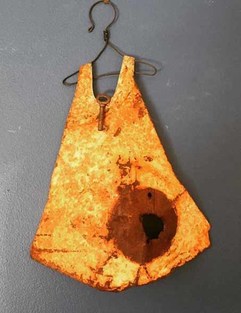
AS MATT, my husband will tell you, it is not often that I am stuck for words. But when I saw Regina Dudek’s amazing garden and workshop full of all sorts of paraphernalia, finished and unfinished works framing larger than life Regina as she banged another piece of metal into shape, all I could think to say was “Wow!”
Words cannot describe the eclectic mix of sculptures in the garden and the array of other people’s cast-off metals, crockery, cutlery, wire and fabrics dotted around the workshop seeking to catch the eye of the artist who can transform them into something unique.
So how does a country girl end up creating these exquisite pieces find herself in our Shire? Regina grew up in Boolarra at, of all things, a goldfish farm, which now supplies three million goldfish to the aquarium industry each year. Her grandfather, Franz, immigrated from Germany in 1951 after being offered a job in a bricklaying team in a briquette factory near Morwell.
When the job finished, he managed to score the 10-hectare farm, which was predominantly a tea tree swamp, as part of the settlement. Instead of putting stock on or growing fruit and vegetables, he started digging ponds. Originally supplying carp to local famers as a popular table fish, he had to destroy his stock after the government declared carp a noxious species. Undaunted, he started breeding goldfish instead.
Regina’s father, Franz Jnr, took over the goldfish farm. Like many born in the war years, he was a mad keen re-purposer. There wasn’t much money so they had to make do. In those days you were free to scavenge at the local tips and nothing was more fun for Regina’s dad, brother and herself than to take themselves off for a tip run. It was in vain that her mother would call out after them, “Don’t come back with more than you’re dropping off!”
At 11 years of age, Regina had already made her first pair of earrings. Nicking some fuse wire from the meter box, she went about threading yellow seed beads onto it with the aid of her mother’s eye brow tweezers. Her life purpose was now set.
Like a bower bird, she started collecting all sorts of bits and bobs and making jewellery not just for herself but for others, and ultimately to sell at local markets. She thought she would be a silversmith but RMIT had limited places so she ended up studying for a bachelor of education in arts and crafts from Melbourne University. She loved her studies, learning 10 disciplines in the first year, pared down to four and ultimately concentrating on just two – metal work and sculpture – in her final year. Regina says, “I can’t draw to save myself. I always think in 3D.”
She started her teaching career only to find the enthusiasm she had for art was not replicated with her students. Even harder was that the parents didn’t encourage their children to be serious about the subject either. They felt art wasn’t important – it simply didn’t matter.
She left country Victoria and teaching behind and headed to Perth. It was just a few years after Australia’s America Cup defence and Freemantle was humming. She found a card table, set up two racks of earrings and almost sold the lot. She thought she had it made. Until the next weekend when she didn’t sell quite so much!
She did, however, draw the attention of the arts centre, where she was asked to teach wire sculpture. She knew where to scavenge some scrap copper and metal and put together a couple of classes. At last she had found students who appreciated the art form. In the end she was teaching classes three days a week. But she found Perth too isolated from family and friends so found her way back to Boolarra.
Her now young family ensconced themselves in a two-storey mud brick home on five acres of land at the top of the hill with the state forest below. In February 2009, the beautiful wooden veranda that encircled their home, and was their go-to place for many a pleasant evening, became the pile of kindling for Black Saturday the fire that destroyed their beautiful home.
If that wasn’t bad enough, Regina also lost her collection of curios that she had acquired over the years, all systematically housed in drawers. They thought about re-building – there was so much support and overwhelming generosity from people they didn’t even know. But then they considered that every summer from thereon in they would be looking over their shoulders. They decided to move to Inverloch.
It may seem a curious choice – but Inverloch had always been Regina’s beach growing up when their family went for weekends away. Her home now is only a five-minute walk to the beach.
Regina has now re-stocked, or at least is re-stocking. She has continued to take the items discarded by others, take them lovingly into her home, and re-fashion them into whimsy. Her latest is all about creating dresses. A full-size sculpture is in her front garden framed by thick aluminium wire, hand twisted and resplendent with embellishments of harvested relics like silver spoons and chandelier crystals. A couple more “dresses” are on her work bench complete with hand-crafted tapestry bodices and old bed mesh skirts.
In a box lies a scattering of wreaths, candle stick holders and bird cages, each one different, each one holding a glimpse of the past and the original purpose. What will she think of next?
Regina is one of the exhibiting artists at ArtSpace who will be holding classes at the Archies Creek Hall over summer time. Her first workshop, Whimsical Wreaths, is on October 31. Bookings 5672 5767 10am-4pm or email [email protected]